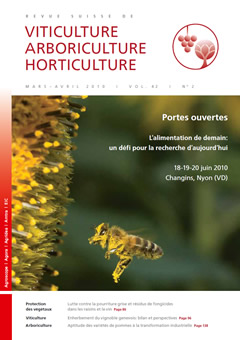
Issue 2 - March - April 2010
Abstract in open access
In the past few years, the Geneva vineyard has significantly changed its soil management practice: permanent grass cover has become a common practice. This article provides a detailed analysis of the grass cover in the canton of Geneva and launches a discussion on opportunities for improvement. It demonstrates that the flora of the vineyard is diverse but dominated by a few species typical of fertilized meadows, occupying a large area. The frequency of mowing does not seem to influence the flora composition. With some small extra effort, the majority of vineyards could be considered as ecological compensation areas, a good advantage for vine growers qualifying for direct payments. For the weeded plots in this study, 50 % could be covered with permanent grass without too much risk. Therefore, there is still much to be done to promote permanent grass cover.
Keywords: vineyards, grass cover, botanical composition
E-Mail: stephane.burgos@eichangins.ch
Adress:
Abstract in open access
Renewable organic substrates were compared from 2005 to 2008 in order to assess the replacement of peat as a substrate for everbearing strawberries production. Moreover, the possibility of recycling coir substrates previously used in tomato cultures was examinated in strawberries production. Results showed that for everbearing strawberries peat can easily be replaced by other substrates such as coir, compost, wood fibres or composted pine bark. There was no significant yield, fruit calibre and fruit quality differences between the various substrates tested. The re-use of coco fibres substrate, previously used in tomato cultures, is possible for strawberries production without incidence on yield, which is an interesting economical and ecological alternative to the use of a new substrate.
Keywords: strawberry, soilless production, alternative substrates peat, coir, composted pine
E-Mail: andre.ancay@acw.admin.ch
Adress:
Abstract in open access
The leafhopper Scaphoideus titanus is the vector of flavescence dorée, a severe grapevine disease spreading in Europe. The project PROPSCAPH brought together four European research institutes in order to improve risk management schemes against the spread of flavescence dorée?s vector on propagation material. Agroscope Changins-Wädenswil, coordinator of the project, studied the impact of hot water treatments on the development of S. titanus eggs. In autumn 2008, one-year-old and two-year-old cuttings were collected in S. titanus infested vineyards in France, Italy and Switzerland. Half of the cuttings were exposed to a hot water treatment and the hatching of S. titanus nymphs was assessed. Our observations confirmed the ability of S. titanus to lay eggs on propagation material. However, hot water treatments reduced the number of hatched nymphs, i. e. the exposure to hot water killed more than 90 % of deposited eggs. Thus, the hot water treatment of rootstocks and scions before grafting or of grafted plants before commercialisation is strongly recommended. This should ensure the distribution of plant material free of flavescence dorée and minimise the risk of vector?s spread.
Keywords: risk management, viticulture, propagation material, nursery
E-Mail: christian.linder@acw.admin.ch
Adress:
Abstract in open access
A good knowledge about the raw material characteristics and its effect on the final product is necessary to improve the quality of processed fruits. The aim of the present work is to study the impact of apples initial quality, and more particularly their mechanical properties, on their capacity to be processed in vacuum cooked fruits. In that order, 1 of the factors known to contribute to variations in fruit texture is tested: the choice of cultivar. The results show that the initial fruit firmness is not related to its ability to be processed, as the most resistant apples to the vacuum cooking were not the firmest ones. The varietal effect seems to be the most important factor. Two apple cultivars appeared to be particularly well adapted to this type of process: Royal Gala and Cripps Pink. Unlikely, in spite of its high firmness level, the Granny Smith cultivar did not resist to the thermal treatments applied during the process.
Keywords: apple, texture, selection, processing
E-Mail: f.jourjon@groupe-esa.com
Adress: Ecole supérieure d'agriculture d'Angers ESA, F-49007 Angers Cedex 01

 Download of full issue
Download of full issue
 Download article
Download article